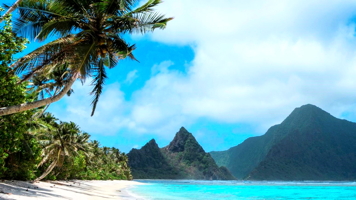
|
Folk Dance Federation of California, South, Inc.
|

|
CLICK AN IMAGE TO ENLARGE
As in Hawaiʻi, the Samoan people enjoy their songs and dances. Late into the evenings and even beyond midnight, you can hear music in the small village. When more than a single family group get together it may well become a Siva (dance).
When a group of visitors from another village or another island come, they usually stay for several days or even weeks. Not long after their arrival, there will be a Siva that can last for three or four days. During the days, the young boys will fish off the reefs and swim in the ocean swells while the mothers and daughters harvest the breadfruits, taro, and green bananas. The men will spend their time talking politics and making new fale (house) blinds or panels, or thatching a neighbor's roof.
When evening comes, and the village people have returned from the ocean and the hills, and the men have taken up their bundles of fibers to plat new ropes, the young men will dance together as the girls clap their hands in rhythm or pound on the ground with their hands. The girls, too, will have their dances, but they seldom actually dance together.
The dancers of Samoa will add flowers to their hair, shell necklaces, anklets, bracelets, and ringlets of leaves and bark on their fingers, head, and arms. Often there will be a hollowed-out stick or log as a drum, or perhaps a section of bamboo three or four inches in diameter and eighteen inches to two feet long will be used as a sounding board to beat out their rhythms.
During the time of the missionaries, there developed a feeling against dancing that has only in recent years been replaced with a desire to relearn the old traditional dances and rhythms.